Why this resume works
- Quantifies accomplishments: Features measurable accomplishments, such as managing budgets for over 10 contracts and saving 15%, highlighting the applicant’s tangible impact and value.
- Highlights industry-specific skills: The applicant emphasizes industry-specific administrative skills, like financial analysis and budget management, aligning with accounting roles.
- Uses action-oriented language: Using action verbs such as “implemented” and “optimized,” the applicant conveys initiative and effectiveness.
More Project Accountant Resume Examples
Explore more project accountant resume examples to learn how to showcase your budgeting skills, cost tracking expertise, and ability to manage financial aspects of projects. These accounting resume samples will help you create a compelling and industry-aligned resume.
Entry-Level Project Accountant
Why this resume works
- Centers on academic background: The education section showcases an MBA in finance and a Bachelor’s degree in accounting, highlighting the applicant’s academic foundation for their early career development.
- Effective use of keywords: Job-relevant keywords like budgeting, financial reporting, and cost analysis are strategically integrated throughout, increasing the chance of passing applicant tracking systems (ATS) and standing out to employers
- Shows digital literacy: Skill with SAP ERP highlights computer skills and digital literacy, showcasing the applicant’s readiness for tech-driven environments.
Mid-Level Project Accountant
Why this resume works
- Points to measurable outcomes: By saving 15% in project costs and reducing audit discrepancies by 30%, the applicant’s clear focus on measurable outcomes boosts confidence in their financial management skills.
- Demonstrates language abilities: The applicant’s language skills in Spanish and French indicate their ability to navigate diverse work environments.
- Includes a mix of soft and hard skills: Combining technical expertise like cost reduction with interpersonal skills, the applicant ensures effective communication alongside analytical achievements.
Experienced Project Accountant
Why this resume works
- Lists relevant certifications: By listing key certifications like CMA and QuickBooks Certified User, the applicant shows their commitment to continuous learning and professional growth.
- Emphasizes leadership skills: Managing $2M budgets across departments and overseeing payroll for over 100 employees showcases strong leadership skills.
- Showcases impressive accomplishments: Standout achievements such as designing a budgeting tool that reduced errors by 25% highlight the applicant’s impact on business efficiency.
Project Accountant Resume Template (Text Version)
John Kim
Parkview, MO 64160
(555)555-5555
John.Kim@example.com
Professional Summary
Accomplished Project Accountant with 8 years’ industry experience. Expertise in budget management, financial reporting, and audit processes. Proficient in financial analysis and contract review, adept at improving financial accuracy and efficiency.
Skills
- Financial Analysis
- Budget Management
- Audit Preparation
- Financial Reporting
- Contract Review
- Data Analysis
- Forecasting
- Reconciliation
Certifications
- Certified Public Accountant (CPA) – American Institute of CPAs
- Certified Management Accountant (CMA) – Institute of Management Accountants
Education
Master of Accounting Accounting
Columbia University New York, NY
June 2016
Bachelor of Business Administration Finance
University of California, Los Angeles Los Angeles, CA
June 2014
Work History
Project Accountant
Strategic Finance Solutions – Parkview, MO
June 2023 – May 2025
- Managed budgets for 10+ contracts saving 15% costs
- Optimized financial reporting resulting in 20% efficiency
- Implemented audit processes reducing errors by 25%
Financial Analyst
Innovative Accounting Services – Parkview, MO
June 2018 – May 2023
- Analyzed financial data improving accuracy by 30%
- Developed forecasts increasing sales by 10%
- Reviewed contracts leading to 5% expense reduction
Accounting Assistant
Smart Finance Corp – St. Louis, MO
June 2016 – May 2018
- Assisted in preparing statements enhancing clarity
- Reconciled accounts achieving 95% accuracy rate
- Collaborated in audits ensuring compliance
Languages
- Spanish – Beginner (A1)
- French – Beginner (A1)
- German – Beginner (A1)
Related Resume Guides
Advice for Writing Your Project Accountant Resume
Explore tips on how to write a resume for a project accountant position and discover how to highlight your skills in financial management and project coordination.
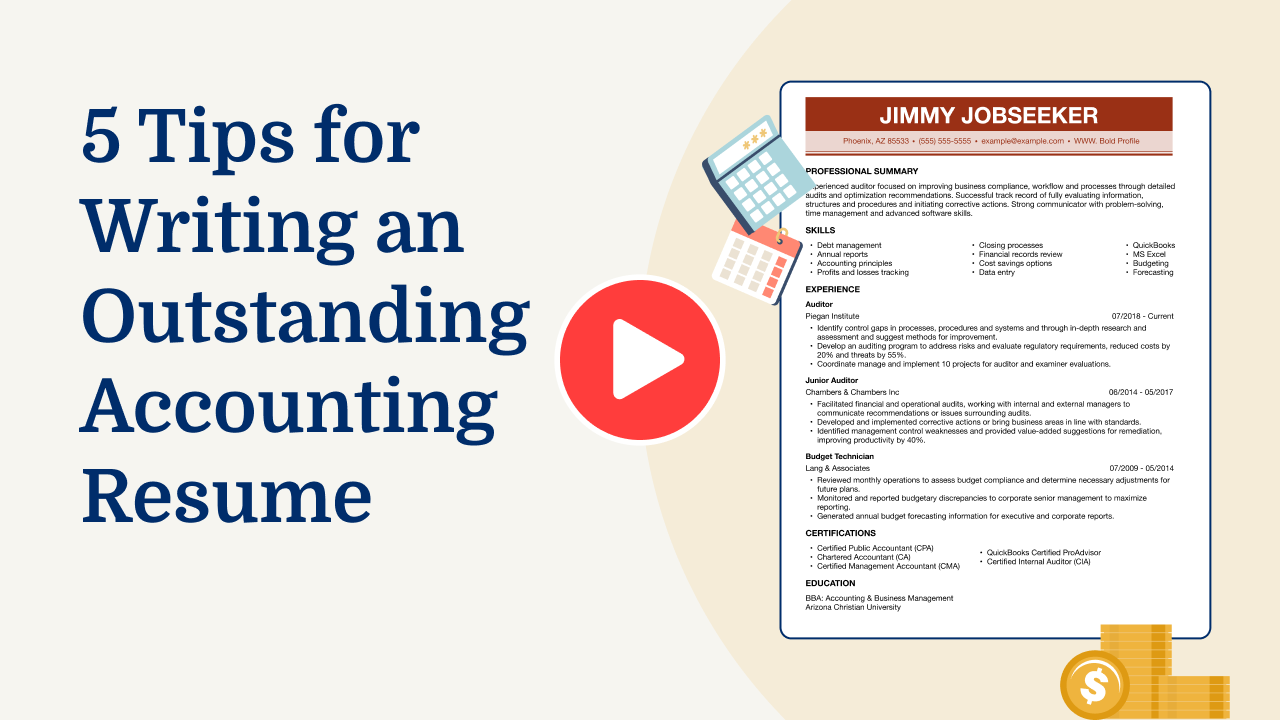
Highlight your most relevant skills
Listing relevant skills when applying for a project accountant job is important because it helps show you have the right abilities for the role. Employers look for specific skills that match their needs, so highlighting these can make your application stand out.
By clearly listing both technical and interpersonal skills, you give a full picture of what you can bring to the team. Technical skills might include budgeting, financial reporting, and using accounting software, while interpersonal skills could be teamwork, communication, and problem-solving.
Creating a skills section in your resume is helpful because it quickly shows employers what you’re good at. Make sure to balance hard skills like data analysis with soft skills like time management. This mix shows you’re well-rounded and capable of handling different aspects of the job.
Weave these key skills into your work experience descriptions. For example, mention how your attention to detail helped catch errors in financial reports or how your teamwork improved project outcomes. This makes your resume stronger and more convincing to hiring managers looking for a great project accountant.
Select a resume format that highlights your experience in managing budgets, financial reporting, and project cost analysis.
Showcase your accomplishments
To organize your work experience effectively, list each job entry in reverse chronological order, starting with the most recent position. For every role, include your job title, the name of your employer, the location where you worked, and the dates of employment. This format helps hiring managers quickly see your most recent and relevant experience as a project accountant.
Rather than just listing responsibilities, focus on turning duties into measurable achievements. Use numbers to show impact—like percentages for cost reductions or time savings—and explain how your actions made a difference.
For example, instead of saying you “monitored budgets,” highlight an accomplishment such as “tracked project expenses and identified cost-saving opportunities that reduced spending by 15%.” Quantifying results makes your resume stand out and shows employers how well you performed in previous roles.
Use strong action words like managed, streamlined, optimized, or analyzed to describe tasks and accomplishments tied to key accounting duties. Highlight successes that align with what a project accountant does, such as improving financial reporting accuracy or reducing delays in billing processes. This approach helps potential employers quickly recognize how you’ve made a positive impact and ensures they see the value you bring to their team.
5 project accountant work history bullet points
- Managed financial reporting for projects valued at $10M+, ensuring accuracy and compliance with accounting standards.
- Implemented cost control measures that reduced project expenses by 12%, contributing to increased profitability.
- Streamlined budget forecasting processes, improving efficiency and reducing time spent on analysis by 25%.
- Coordinated with cross-functional teams to resolve billing discrepancies, recovering over $250K in outstanding invoices.
- Developed a comprehensive project accounting system, improving transparency and accountability across multiple projects.
Pick a simple, neat resume template. Use clear section titles and easy-to-read fonts. Skip the fancy graphics to make sure your skills and job history are easy to see.
Write a strong professional summary
A professional summary on a resume acts as your introduction to hiring managers, offering a snapshot of who you are as a worker and what makes you valuable. When crafting your resume, you’ll need to decide between including a summary or an objective based on your experience level and career goals.
A professional summary is typically three to four sentences that highlight your experience, key skills, and standout accomplishments. It’s best suited for applicants with solid work history in their field—like experienced project accountants—and helps establish your professional identity while showcasing the value you bring to the role.
Resume objectives are statements about career aspirations and the contributions you aim to make in a new role. They are better for entry-level workers, career changers, or those with gaps in employment who may lack direct experience but want to share their goals. Unlike summaries, objectives emphasize “what I aim to contribute.”
Next, we’ll provide examples of both summaries and objectives tailored for various industries and levels of experience. Explore our library of resume examples for additional inspiration.
Project accountant resume summary examples
Entry-level
Recent graduate with a Bachelor of Science in Accounting, aspiring project accountant with foundational knowledge in financial reporting and budgeting. Completed an internship at a construction firm, gaining exposure to cost tracking and variance analysis. Eager to leverage skills in Microsoft Excel and QuickBooks to support project management teams in achieving financial objectives.
Mid-career
Project accountant with over six years of experience in the engineering industry, adept at managing budgets for large-scale projects and ensuring compliance with financial regulations. Proven track record of improving cost efficiency through detailed analysis and strategic forecasting. Expertise in SAP and Oracle Financials, known for effective communication with cross-functional teams to streamline accounting processes.
Experienced
Highly experienced project accountant with over 15 years specializing in infrastructure projects. Expertise includes leading financial planning and analysis for multi-million dollar ventures, optimizing cost controls, and mitigating financial risks. Recognized for implementing innovative accounting methodologies that improved project profitability by 20%. Skilled mentor committed to developing future accounting leaders.
Project accountant resume objective examples
Recent graduate
Detail-oriented recent accounting graduate with coursework in financial analysis and project management, seeking an entry-level project accountant role to apply academic knowledge in budgeting and cost tracking. Committed to supporting project teams by ensuring accurate financial reporting and contributing to organizational success.
Career changer
Analytical professional transitioning into project accounting, bringing a solid background in business operations and data management. Eager to leverage transferable skills in organization and problem-solving to support financial planning and resource allocation for diverse projects.
Specialized training
Entry-level project accountant with advanced training in ERP systems and cost control methodologies, aiming to join a forward-thinking company. Passionate about using technical expertise to assist teams in achieving on-budget completion of projects through effective financial oversight.
Need help creating a standout resume? Use our Resume Builder to make the process easy and get a professional-looking project accountant resume in no time.
Match your resume to the job description
Tailoring resumes to job descriptions is essential because it helps job seekers stand out and pass through applicant tracking systems (ATS). Many companies use ATS to filter resumes before a human ever sees them. These systems scan for specific keywords and phrases from the job posting. If your resume doesn’t include these terms, it might not even reach the hiring manager.
An ATS-friendly resume includes keywords that match those in the job description. By aligning these words with your skills and experiences, you increase your chances of getting noticed. This means using terms like “project management,” “financial reporting,” or “budget analysis” if you’re applying for a project accountant role.
To find the right keywords, carefully read the job posting. Look for repeated skills, qualifications, and duties. Incorporating these terms naturally into your resume is important. Instead of listing tasks, rewrite them to reflect the language in the job posting. For example, change “managed budgets” to “managed project budgets effectively and efficiently.”
Targeted resumes improve ATS compatibility by ensuring they contain relevant keywords from job descriptions. Creating a customized resume increases the likelihood of landing an interview since your resume is more likely to be seen by hiring managers.
Make sure your resume passes ATS software checks! Our ATS Resume Checker reviews your format and keywords, helping you get noticed by hiring managers.
FAQ
Do I need to include a cover letter with my project accountant resume?
Yes, it’s a good idea to include a cover letter with your project accountant resume. A cover letter lets you highlight your specific skills and experiences in financial management and accounting that match the job description.
You can use resources like our Cover Letter Generator to craft an impressive introduction. It also gives you the chance to explain your interest in the company’s projects or financial strategies and how you can contribute to their success.
You can showcase any specialized skills, such as expertise in accounting software or experience managing budgets for large-scale projects. Consider exploring cover letter examples specifically for project accountants to ensure your cover letter supports your application effectively.
How long should a project accountant’s resume be?
For a project accountant, aim for a concise one-page resume that emphasizes key skills like financial analysis, budget management, and skill with accounting software.
If you have extensive experience or specialized certifications in project accounting, opting for a two-page resume can be fitting. Ensure every detail is relevant and highlights your ability to manage project finances effectively.
Focus on recent roles and achievements that show your capability to handle complex projects. Check out our guide on how long a resume should be for more tips tailored to your career stage.
How do you write a project accountant resume with no experience?
If you’re beginning as a project accountant without direct experience, emphasize your education, transferable skills, and related coursework or projects:
- Emphasize education: Start with your degree in accounting or finance. Include your graduation date, the name of the institution, and any honors or relevant coursework like “project management” or “financial Reporting.”
- Highlight internships and academic projects: If you’ve completed internships or school projects related to accounting or finance, detail these experiences. Focus on tasks that mirror project accounting duties such as budgeting, cost tracking, or financial analysis.
- Showcase transferable skills: Highlight skills like attention to detail, skill in Excel or other accounting software, and analytical abilities. If you’ve worked in roles requiring organization and problem-solving, weave those into your resume.
- Include certifications: If you have certifications such as CPA (in progress) or courses from platforms like Coursera on project management or accounting basics, list them prominently.
Check out this guide on creating a resume with no experience for more helpful tips.
Rate this article
Project Accountant
Additional Resources
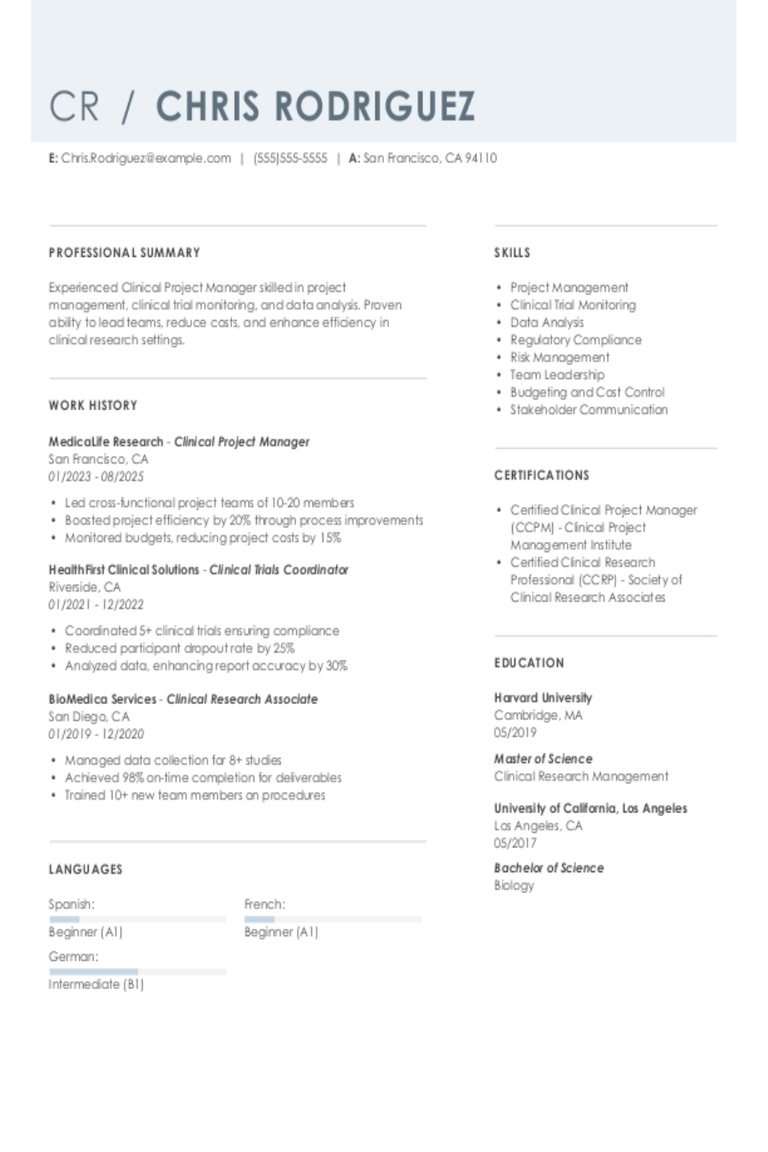
Clinical Project Manager Resume Examples & Templates for 2025
Explore clinical project manager resume examples to learn how to showcase your leadership in guiding medical studies and coordinating research teams. Get tips on emphasizing your ability to manage timelines,
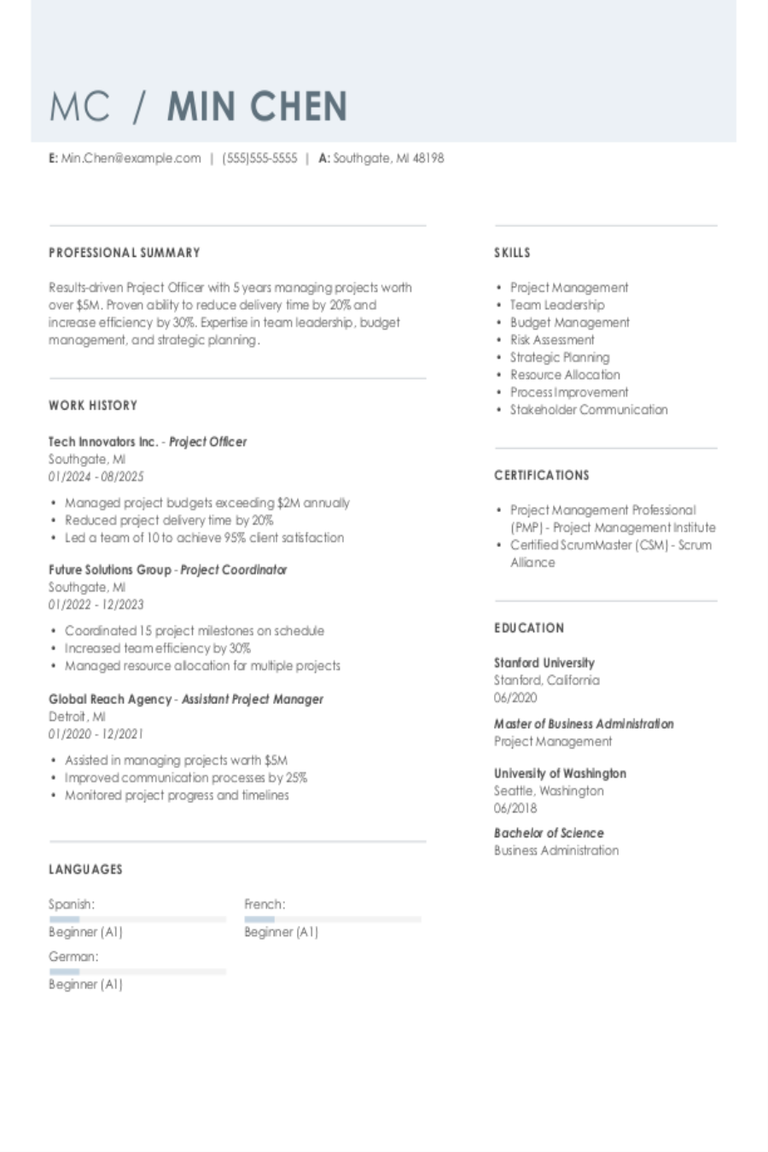
Project Officer Resume Examples & Templates for 2025
Explore project officer resume examples and tips to learn how to showcase how you manage timelines, coordinate teams, and handle budgets.Build my resumeImport existing resumeCustomize this templateWhy this resume worksQuantifies
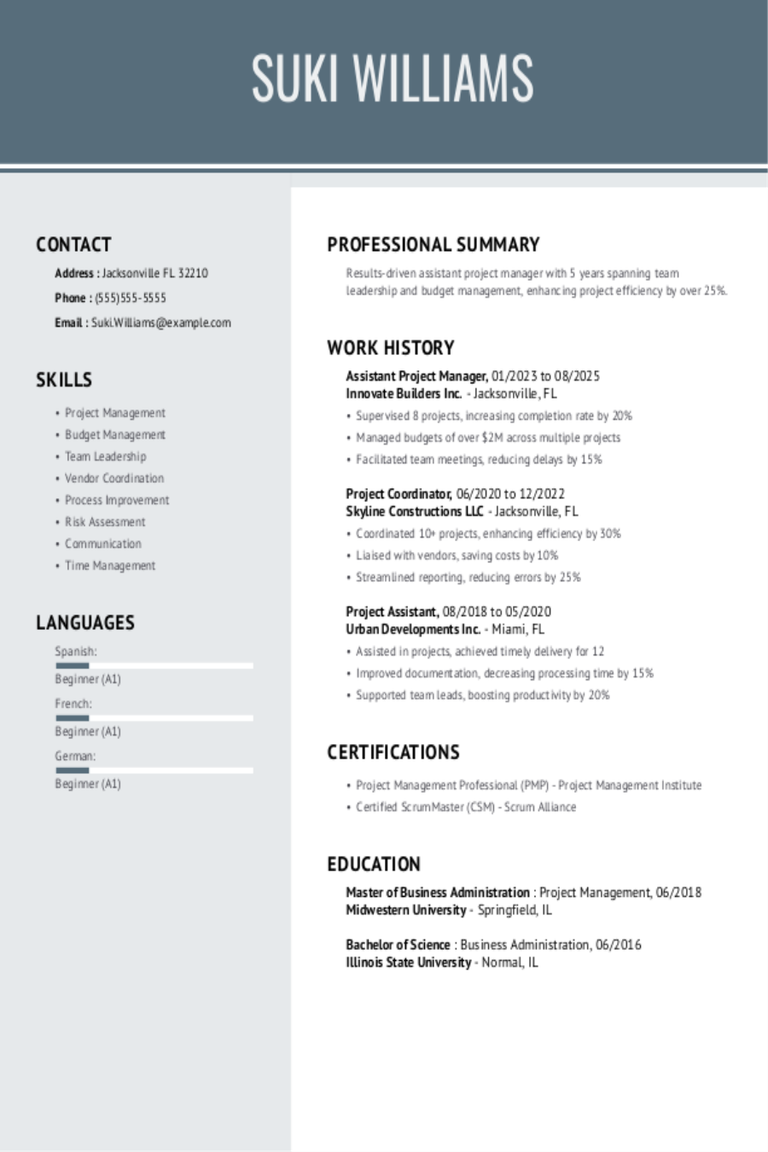
Assistant Project Manager Resume Examples & Templates for 2025
Discover assistant project manager resume examples and tips to help you craft a resume that highlights your planning skills and project experience.Build my resumeImport existing resumeCustomize this templateWhy this resume
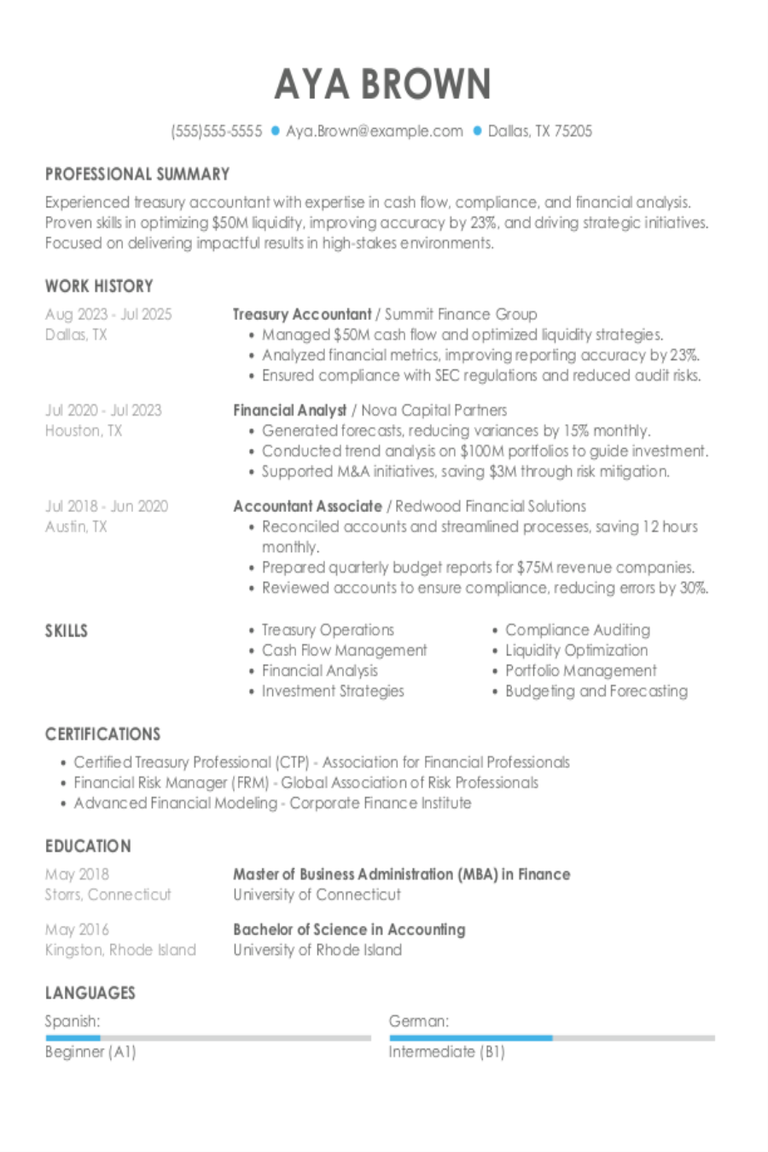
Treasury Accountant Resume Examples & Templates for 2025
Explore treasury accountant resume examples and learn how to show you handle cash flow, manage investments, and analyze financial data.Build my resumeImport existing resumeCustomize this templateWhy this resume worksQuantifies accomplishments: By

Financial Project Manager Resume Examples & Templates for 2025
Discover financial project manager resume examples and learn how to show you handle budgets, lead teams, and keep projects on track.Build my resumeImport existing resumeCustomize this templateWhy this resume worksQuantifies
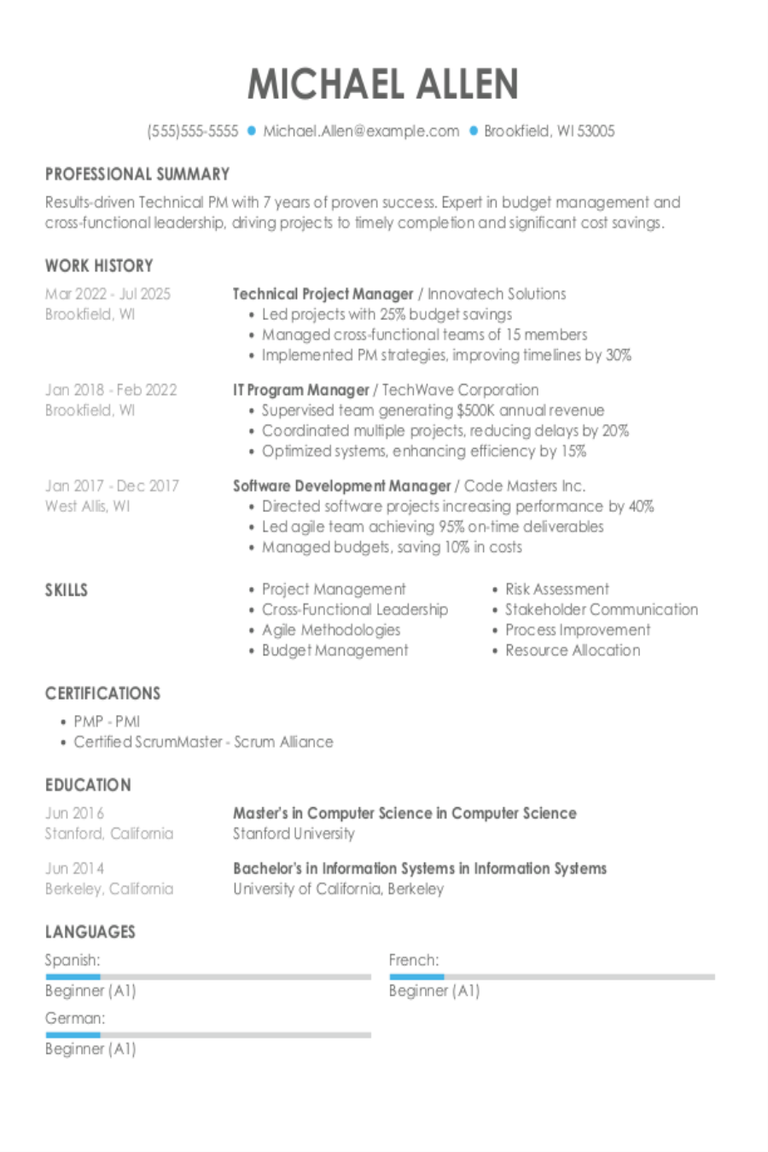
Technical Project Manager Resume Examples & Templates for 2025
Explore technical project manager resume examples that demonstrate expertise in managing software development, cloud integration, and cross-functional team leadership. Browse actionable tips on how to highlight your technical skills, Agile
